Counting of the Omer
Counting of the Omer (Hebrew: סְפִירַת הָעוֹמֶר, Sefirat HaOmer, sometimes abbreviated as Sefira or the Omer) is an important verbal counting of each of the forty-nine days starting with the Wave Offering of a sheaf of ripe grain with a sacrifice immediately following the commencement (Hebrew: רֵאשִׁית, reishit) of the grain harvest, and the First Fruits festival celebrating the end of the grain harvest, known as Feast of Weeks/Shavuot/Pentecost in Mosaic Law (Hebrew Bible: Deuteronomy 16:9–12, Leviticus 23:10–16); or in the varying current Jewish holidays traditions, the period between the Passover or Feast of Unleavened Bread, and Shavuot. This is the second of the three annual Mosaic Law feast periods.
| Counting of the Omer | |
|---|---|
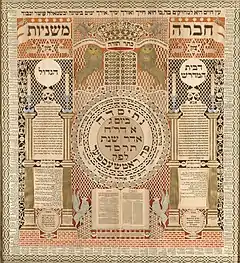 Omer Calendar | |
| Observed by | Jews. (In various forms also by: Samaritans; Messianic Jews; Christians, some groups claiming affiliation with Israelites). |
| Type | Jewish and Samaritan (One of the Three Pilgrimage Festivals), cultural |
| Begins | 16 Nisan |
| Ends | 5 Sivan |
| 2020 date | Sunset, 9 April – nightfall, 28 May |
| 2021 date | Sunset, 28 March – nightfall, 16 May |
| 2022 date | Sunset, 16 April – nightfall, 4 June |
| 2023 date | Sunset, 6 April – nightfall, 25 May |
| Related to | Passover, Shavuot |
| Part of a series on |
| Judaism |
|---|
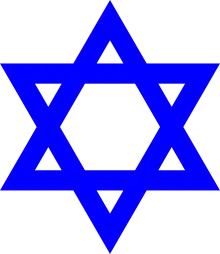 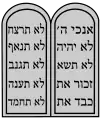  |
|
This mitzvah ("commandment") derives from the Torah commandment to count forty-nine days beginning from the day on which the Omer, a sacrifice containing an omer-measure of barley, was offered in the Temple in Jerusalem, up until the day before an offering of wheat was brought to the Temple on Shavuot. The Counting of the Omer begins on the second day of Passover (the 16th of Nisan) for Rabbinic Jews (Orthodox, Conservative, Reform), and after the weekly Shabbat during Passover for Karaite Jews, and ends the day before the holiday of Shavuot, the 'fiftieth day.'
The idea of counting each day represents spiritual preparation and anticipation for the giving of the Torah[1] which was given by God on Mount Sinai at the beginning of the month of Sivan, around the same time as the holiday of Shavuot. The Sefer HaChinuch (published anonymously in 13th-century Spain) states that the Israelites were only freed from Egypt at Passover in order to receive the Torah at Sinai, an event which is now celebrated on Shavuot, and to fulfill its laws. Thus the Counting of the Omer demonstrates how much a Jew desires to accept the Torah in their own life.
Sources
The commandment for counting the Omer is recorded within the Torah in Leviticus 23:9–21:
9 And the LORD spoke unto Moses saying: 10 Speak unto the children of Israel, and say unto them: When ye are come into the land which I give unto you, and shall reap the harvest thereof, then ye shall bring the sheaf of the first-fruits of your harvest unto the priest.
11 And he shall wave the sheaf before the LORD, to be accepted for you; on the morrow after the sabbath the priest shall wave it. 12 And in the day when ye wave the sheaf, ye shall offer a he-lamb without blemish of the first year for a burnt-offering unto the LORD. 13 And the meal-offering thereof shall be two tenth parts of an ephah of fine flour mingled with oil, an offering made by fire unto the LORD for a sweet savour; and the drink-offering thereof shall be of wine, the fourth part of a hin. 14 And ye shall eat neither bread, nor parched corn, nor fresh ears, until this selfsame day, until ye have brought the offering of your God; it is a statute for ever throughout your generations in all your dwellings. {S} 15 And ye shall count unto you from the morrow after the day of rest, from the day that ye brought the sheaf of the waving; seven weeks shall there be complete; 16 even unto the morrow after the seventh week shall ye number fifty days; and ye shall present a new meal-offering unto the LORD. 17 Ye shall bring out of your dwellings two wave-loaves of two tenth parts of an ephah; they shall be of fine flour, they shall be baked with leaven, for first-fruits unto the LORD. 18 And ye shall present with the bread seven lambs without blemish of the first year, and one young bullock, and two rams; they shall be a burnt-offering unto the LORD, with their meal-offering, and their drink-offerings, even an offering made by fire, of a sweet savour unto the LORD. 19 And ye shall offer one he-goat for a sin-offering, and two he-lambs of the first year for a sacrifice of peace-offerings. 20 And the priest shall wave them with the bread of the first-fruits for a wave-offering before the LORD, with the two lambs; they shall be holy to the LORD for the priest. 21 And ye shall make proclamation on the selfsame day; there shall be a holy convocation unto you; ye shall do no manner of servile work; it is a statute for ever in all your dwellings throughout your generations.
And ye shall count unto you from the morrow after the day of rest, from the day that ye brought the omer of the waving; seven weeks shall there be complete;
As well as in Deuteronomy 16:9–12:
9 Seven weeks shalt thou number unto thee; from the time the sickle is first put to the standing corn shalt thou begin to number seven weeks.
10 And thou shalt keep the feast of weeks unto the LORD thy God after the measure of the freewill-offering of thy hand, which thou shalt give, according as the LORD thy God blesseth thee. 11 And thou shalt rejoice before the LORD thy God, thou, and thy son, and thy daughter, and thy man-servant, and thy maid-servant, and the Levite that is within thy gates, and the stranger, and the fatherless, and the widow, that are in the midst of thee, in the place which the LORD thy God shall choose to cause His name to dwell there.
12 And thou shalt remember that thou wast a bondman in Egypt; and thou shalt observe and do these statutes.
However, the obligation in post-Temple destruction times is a matter of some dispute. While Rambam (Maimonides) suggests that the obligation is still biblical, most other commentaries assume that it is of a rabbinic origin in modern times.
Background
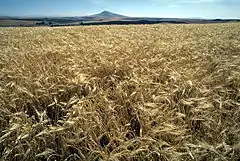
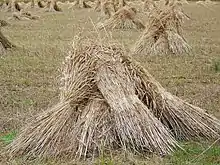
The omer a ("sheaf") is an old Biblical measure of volume of unthreshed stalks of grain. The Sunday after the start of each farmer's barley grain harvest, a sheaf of barley from each farm was waved by a Priest in the Temple in Jerusalem, signalling the allowance of the consumption of chadash (grains from the new harvest). Later tradition evolved to: during the Feast of Unleavened Bread, an omer of barley was offered in the Temple in Jerusalem, signalling the allowance of the consumption of chadash (grains from the new harvest). This offering happened on "the morrow after the day of rest", evolving to be re-interpreted either as the second day of Unleavened Bread on the 16th day of the month or as they day following the Shabbat during Passover. On the 50th day after the beginning of the count, corresponding to the holiday of Shavuot, two loaves made of wheat were offered in the Temple to signal the end of the wheat harvest or the re-interpreted beginning of the wheat harvest.
The origins of the "omer" count are from the Torah passages on the offerings for the start and end of grain harvest, with the 50th day marking the official end with a large feast. The Torah itself, in Leviticus 23:15–16, and Deuteronomy 16:9–12, states that it is a commandment to count seven complete weeks from the start of the grain harvest ending with the festival of Shavuot on the fiftieth day. Shavuot has evolved to be known as the festival marking the giving of the Torah to the Hebrew nation on the 6th of the Hebrew month of Sivan.
Some later rabbinic sources link the omer count to the Israelites' experience in the desert. According to these sources, at the time of the Exodus, Moses announced that 50 days later they would celebrate a religious ceremony at Mount Sinai. The populace was so excited by this that they counted the days until that ceremony took place. Later (according to the sources), when the Temple was destroyed and the omer offering ceased, the rabbis instituted omer counting as a remembrance of the counting up to Sinai.[2]
In keeping with the themes of spiritual growth and character development during this period, Rabbinic literature[3] compares the process of growth to the two types of grain offered at either pole of the counting period. In ancient times, barley was simpler food while wheat was a more luxurious food. At Passover, the children of Israel were raised out of the Egyptian exile although they had sunken almost to the point of no return. The Exodus was an unearned gift from God, like the food of simple creatures that are not expected to develop their spiritual potential. The receiving of the Torah created spiritual elevation and active cooperation. Thus the Shavuot offering is "people food".[3]
The count
As soon as it is definitely night (approximately thirty minutes after sundown), the one who is counting the Omer recites this blessing:
Barukh atah A-donai E-loheinu Melekh Ha-ʿolam asher qid'shanu b'mitzvotav v'tzivanu ʿal S'firat Ha-ʿomer. (Translation: Blessed are You, Lord our God, King of the Universe, Who has sanctified us with His commandments and commanded us to count the Omer.)
Then he or she states the Omer-count in terms of both total days and weeks and days. For example, on the 23rd day the count would be stated thus: "Today is twenty-three days, which is three weeks and two days 'of' [or] 'to' (לעומר) [or] 'in' (בעומר) the Omer".[4] The count is said in Hebrew.
According to the Halakha, a person may only recite the blessing while it is still night. If he or she remembers the count the next morning or afternoon, the count may still be made, but without a blessing. If one forgets to count a day altogether, he or she may continue to count succeeding days, but without a blessing. The Omer may be counted in any language, however one must understand what one is saying.[5]
Karaite and Samaritan practice
Karaite Jews and Israelite Samaritans begin counting the Omer on the day after the weekly Sabbath during the Feast of Unleavened Bread – Passover, rather than on the second day of Passover (the 16th of Nisan). There are several reasons for this. On the one hand, Shavuot is the only holiday for which the date is not expressly given in the Torah. Instead, the Torah tells us to determine the date of Shavuot by counting 50 days from the "morrow after the day of rest" (Leviticus 23:15–16).[6]
A difference between Karaites and Samaritans as opposed to Rabbinic Jews is the understanding of "morrow after the day of rest". Rabbinic Jews take the "day of rest" as the 1st day of Passover, while Karaites and Samaritans interpret this Sabbath to be the first weekly Sabbath that falls during Passover. As a result the Karaite and Samaritan Shavuot is always on a Sunday, although the actual Hebrew date varies (which complements the fact that a specific date is never given for Shavuot in the Torah, the only holiday for which this is the case).[7][8][9] The counting of Karaite and Rabbinic Jews coincides when the first day of Passover is on the Sabbath. Because the date of the Samaritan Passover usually differs from the Jewish one,[10] often by as much as a month, the Karaite and Samaritan counting rarely coincides.
Other non-Rabbinical religious leaders such as Anan ben David (founder of the Ananites); Benjamin al-Nahawandi (founder of the Benjaminites); Ismail al-Ukbari (founder of a 9th-century messianic Jewish movement in Babylon); Musa of Tiflis (founder of a 9th-century Jewish movement in Babylon); and Malik al Ramli (founder of a 9th-century Jewish movement in the Land of Israel) additionally recognized that Shavuot should fall out on a Sunday.[11]
Catholics[12] and the historical Sadducees and Boethusians, dispute the Rabbinic interpretation. They infer the "Shabbat" referenced is the weekly Shabbat. Accordingly, the counting of the Omer always begins on the Sunday of Passover, and continues for 49 days, so that Shavuot would always fall on a Sunday as well.
Omer-counters
"Omer-counters" (לוּחַ סְפִירָה הָעוֹמֶר) are typically offered for sale during this time, and are displayed in synagogues for the benefit of worshippers who count the Omer with the congregation at the conclusion of evening services. Omer-counters range from decorative boxes with an interior scroll that shows each day's count through a small opening; to posters and magnets in which each day's count is recorded on a tear-off piece of paper; to calendars depicting all seven weeks and 49 days of the Omer, a small pointer is advanced from day to day; to pegboards that keep track of both the day and the week of the Omer. Reminders to count the Omer are also produced for tablet computers and via SMS services for cell phones.
As a period of semi-mourning
| Repentance in Judaism Teshuva "Return" |
|---|
|
Repentance, atonement and higher ascent in Judaism |
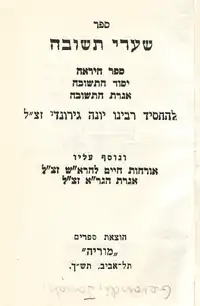 |
| In the Hebrew Bible |
|
Altars · Korban Temple in Jerusalem Prophecy within the Temple |
| Aspects |
|
Confession · Atonement Love of God · Awe of God Mystical approach Ethical approach Meditation · Services Torah study Tzedakah · Mitzvot |
| In the Jewish calendar |
|
Month of Elul · Selichot Rosh Hashanah Shofar · Tashlikh Ten Days of Repentance Kapparot · Mikveh Yom Kippur Sukkot · Simchat Torah Ta'anit · Tisha B'Av Passover · The Omer Shavuot |
| In contemporary Judaism |
|
Baal Teshuva movement Jewish Renewal · Musar movement |
The period of counting the Omer is also a time of semi-mourning, during which traditional Jewish custom forbids haircuts, shaving, listening to instrumental music, or conducting weddings, parties, and dinners with dancing.[13] Traditionally, the reason cited is that this is in memory of a plague that killed the 24,000 students of Rabbi Akiva (ca. 40–ca. 137 CE). According to the Talmud, 12,000 chavruta (pairs of Torah study partners), 24,000 in all, were killed (they were either killed by the Romans during the Bar Kokhba revolt 132–136 CE or they died in a "plague") as a sign of Divine anger during the days of the Omer-counting for not honoring one another properly as befits Torah scholars.
Lag BaOmer, the thirty-third day of the Counting of the Omer, is considered to be the day in which the plague was lifted, (and/or the day in which the rebellion saw a victory during the uprising of Bar Kochba) so on that day, all the rules of mourning are lifted.
Some Sephardi Jews however, continue the mourning period up until the 34th day of the Omer, which is considered by them to be the day of joy and celebration. Spanish and Portuguese Jews do not observe these customs. Some religious Jews shave each Friday afternoon during the mourning period of the Omer in order to be neat in honor of the Shabbat, and some men do so in order to appear neat in their places of employment.
In practice, different Jewish communities observe different periods of mourning. Some families listen to music during the week of Passover and then commence the period of mourning until Lag BaOmer. Some Sephardic Jewish families begin the period of mourning from the first day of the Hebrew month of Iyar and continue for thirty-three days until the third of Sivan. The custom among Jerusalemites (minhag Yerushalmi) is to follow the mourning practices during the entire Counting of the Omer, save for the day of Lag BaOmer and the last three days of the counting (sheloshet yemei hagbalah) prior to the onset of Shavuot. The extent of mourning is also based heavily on family custom, and therefore Jews will mourn to different degrees.
Rabbi Yechiel Michel Epstein (1829–1908), author of Aruch HaShulchan, postulates that the mourning period also memorializes Jews who were murdered during the Crusades (the 11th-, 12th- and 13th-century religious military campaigns), pogroms (19th- and 20th-century attacks on Jews in the Russian Empire) and blood libels that occurred in Europe.[14] In modern times, the Holocaust is generally included among those events which are memorialized, in particular Yom Hashoah is observed during the Omer.[15]
The Jewish calendar is largely agricultural, and the period of Omer falls between Passover and Shavuot. On Passover there is a shift from praying for rain to praying for dew and this coincides with the growth period for the fruit of the season. Shavuot is the day of the giving of the first fruits (bikkurim). The outcome of the season's crop and fruit was still vulnerable during this period. Over these seven weeks, daily reflection, work on improving one's personality characteristics (middot) and potential inner growth from this work on one self was one way to pray for and invite the possibility of affecting one's external fate and potential – the growth of the crop and the fruit of that season.
Although the period of the Omer is traditionally a mourning one, on Lag BaOmer Jews can do actions that are not allowed during mourning. Many Religious Zionists trim their beards or shave their growth, and do other actions that are typically not allowed during the mourning period, on Yom Ha'atzmaut (Israel's Independence Day).
Lag BaOmer
Besides being the day on which the plague affecting Rabbi Akiva's students ceased, Lag BaOmer is traditionally observed as marking the commemoration of the death (Yahrzeit in Yiddish) of Rebbi Shimon bar Yochai, a famous 1st-century Jewish sage in ancient Israel. After the death of Rabbi Akiva's 24,000 students, Rabbi Akiva taught five students, among them Rebbi Shimon. The latter went on to become the greatest teacher of Torah in his generation. According to tradition, on the day of his death, he revealed the deepest secrets of the Torah in a Kabbalistic work called the Zohar.
According to the Zohar, Rabbi Shimon's house was filled with fire and light that entire day as he taught his students. At the end of the day, the fire subsided and Rabbi Shimon died.[16] On successive years, his students sought to recreate that experience of light and mystical revelation by kindling bonfires and studying the Zohar in the light of the flames.
Although the anniversary of the death of a righteous person (tzadik) is usually a mournful day, the anniversary of Rebbi Shimon's death on Lag BaOmer is a festive one. Bonfires are lit and people sing and dance by the flames. Weddings, parties, listening to music, picnics, and haircuts are commonplace.

According to the Talmud, Rebbi Shimon bar Yohai criticized the Roman government and was forced to go into hiding with his son Elazar for thirteen years. They sheltered in a cave (which local tradition places in Peki'in). Next to the mouth of the cave a carob tree sprang up and a spring of fresh water gushed forth. Provided against hunger and thirst they cast off their clothing except during prayers to keep them from wearing out, embedded themselves in the sand up to their necks, and studied the Torah all day long. He and his son left the cave when they received a Heavenly voice saying that the Roman Emperor had died and consequently all his decrees were abolished.[17] According to tradition, they left their place of hiding on Lag BaOmer, and while when they were in hiding in the cave they studied Torah together in their cramped space accepting each other's presence and from that study there came forth the basis of the Zohar's mystical revelations which in a sense was regarded as a "replacement" for the Torah that was "lost" as a result of the death of the 24,000 disciples of Rabbi Akiva. This is another reason to celebrate the "light" of the Zohar which means "splendor" or "radiance" in Hebrew.
Kabbalistic interpretation
The period of the counting of the Omer is considered to be a time of potential for inner growth – for a person to work on one's good characteristics (middot) through reflection and development of one aspect each day for the 49 days of the counting.
In Kabbalah, each of the seven weeks of the Omer-counting is associated with one of the seven lower sefirot:
- Chesed (loving-kindness),
- Gevurah (might),
- Tipheret (beauty),
- Netzach (victory),
- Hod (acknowledgment),
- Yesod (foundation),
- Malchut (kingdom).
Each day of each week is also associated with one of these same seven sefirot, creating forty-nine permutations. The first day of the Omer is therefore associated with "chesed that is in chesed" (loving-kindness within loving-kindness), the second day with "gevurah that is in chesed" (might within loving-kindness); the first day of the second week is associated with "chesed that is in gevurah" (loving-kindness within might), the second day of the second week with "gevurah that is in gevurah" (might within might), and so on.
Symbolically, each of these 49 permutations represents an aspect of each person's character that can be improved or further developed. Rabbi Simon Jacobson (b. 1956), a Chabad Hasidic teacher, explains these 49 levels in his book, The Spiritual Guide to Counting the Omer,[18][19] as do Rabbi Yaacov Haber and Rabbi David Sedley in their book Sefiros: Spiritual Refinement through Counting the Omer.[20] A meditative approach is that of Rabbi Min Kantrowitz in Counting the Omer: A Kabbalistic Meditation Guide[21] which includes meditations, activities and kavvanot (proper mindset) for each of the kabbalistic four worlds for each of the 49 days.
The forty-nine-day period of counting the Omer is also a conducive time to study the teaching of the Mishnah in Pirkei Avoth 6:6, which enumerates the "48 ways" by which Torah is acquired. Rabbi Aharon Kotler (1891–1962) explains that the study of each "way" can be done on each of the first forty-eight days of the Omer-counting; on the forty-ninth day, one should review all the "ways."[22]
See also
- Bible code, a purported set of secret messages encoded within the Torah.
- Biblical and Talmudic units of measurement
- Chol HaMoed, the intermediate days during Passover and Sukkot.
- Chronology of the Bible
- Gematria, Jewish system of assigning numerical value to a word or phrase.
- Hebrew calendar
- Hebrew numerals
- Jewish and Israeli holidays 2000–2050
- Lag BaOmer, 33rd day of counting the Omer.
- Notarikon, a method of deriving a word by using each of its initial letters.
- Sephirot, the 10 attributes/emanations found in Kabbalah.
- Significance of numbers in Judaism
- Weekly Torah portion, division of the Torah into 54 portions.
References
- Scherman, Nosson (translation and anthology) (1984). The Complete ArtScroll Siddur (Nusach Ashkenaz) (First Impression ed.). Brooklyn, NY, USA: Mesorah Publications, Ltd. p. 283. ISBN 0-89906-650-X.
- Aruch Hashulchan Orach Chaim 489:2; quoting Ran, end of Pesachim; the midrash in question appears not to be preserved in any extant midrash collection. Text in Aruch Hashulchan:ובהגדה אמרו בשעה שאמר להם משה תעבדון את אלקים על ההר הזה אמרו לו ישראל משה רבינו אימתי עבודה זו אמר להם לסוף נ' יום והיו מונין כל אחד ואחד לעצמו מכאן קבעו חכמים לספירת העומר כלומר בזמן הזה שאין אנו מביאין קרבן ולא עומר אלא מחשבין נ' יום לשמחת התורה כמו שמנו ישראל באותו זמן וזהו דרך דרש
- Weisz, Noson. "Mind Over Matter". Aish HaTorah, Israel. Retrieved 7 April 2013.
- Bulman, Nachman. "Ask The rabbi". Shulchan Oruch, Orach Chaim 489:1, 493:2; Mishneh Brurah 489:8. Ohr Somayach, Israel. Retrieved 7 April 2013. The Sephardic text of the count uses a slightly different order of words.
- Torah.org. "Sefiras Ha'Omer". Project Genesis, USA. Archived from the original on 30 March 2013. Retrieved 7 April 2013.
- "Karaites Counting the Omer".
- "Count for the Omer".
- "What is shavuot?".
- "Samaritan Shavuot".
- "The Samaritan calendar".
- Ankori, Zvi. Karaites in Byzantium. p. 276.
- Kohler, Kaufmann; Magnus, J. L. (2002). "Pentecost". Jewish Encyclopedia. Retrieved May 29, 2009.
- Karo, Joseph. "Shulkhan Aruch". Sefaria.
- Kahn, Ari. "Rebbe Akiva's 24,000 Students". Aish HaTorah, Israel. Retrieved 8 April 2013.
- Rosenberg, Jennifer (2010-01-01). "How Is Holocaust Remembrance Day Observed by the Jewish Community?". ThoughtCo.
- Simmons, Shraga. "Lag B'Omer: Remembering Rabbi Shimon". Aish HaTorah, Israel. Retrieved 8 April 2013.
- Talmud, b. Shabbat 33b
- Jacobson, Simon. "Your Guide to Personal Freedom Counting the Omer: Week One". Excerpt from "A Spiritual Guide to Counting the Omer". meaningfullife.com. Archived from the original on 10 March 2013. Retrieved 8 April 2013.
- Jacobson, Simon (1996). Spiritual Guide to the Counting of the Omer. Meaningful Life Center. p. 72. ISBN 978-1886587236.
- Yaacov Haber with David Sedley (2008). Sefiros: Spiritual Refinement Through Counting the Omer. TorahLab. p. 160. ISBN 978-1-60763-010-4.
- Kantrowitz, Min (2009). Counting the Omer: A Kabbalistic Meditation Guide. Gaon Books. p. 244. ISBN 978-1-935604-00-6.
- Weinberg, Noah. "Counting with the 48 Ways". Aish HaTorah, Israel. Retrieved 8 April 2013.
External links
- Sefirat ha'omer/Counting the Omer, by Rabbi Julian Sinclair, April 28, 2011; Jewish Chronicle Online
- Encyclopedia Judaica on Jewish Virtual Library
- Spiritual practices and reflections for each day from Mishkan Tefilah
- The traditional liturgy from Chabad
- Rabbi Eliezer Melamed – Peninei Halacha – Counting the Omer
- Rabbi Yitzchak Ginsburgh - Short video teachings for each day of the Omer